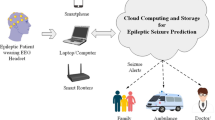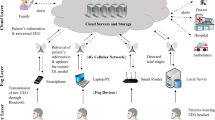Abstract
Epilepsy, a highly prevalent neurological disorder, profoundly impacts the lives of patients with periodic and unexpected seizures that lead to serious injury or death. This research work introduces a Siamese Convolutional Fire Hawk Sparse Autoencoder Network (SCFHSAN) to detect different states of the epileptic seizures. Initially, the EEG signals are gathered from two datasets including TUH EEG and UoB datasets. Then, artifacts removal is performed by multi-resolutional analysis and adaptive filtering technique. After that, dandelion tunable Q-wavelet transform is used to decompose signals into frequency sub-bands. Following that, the feature extraction and feature selection are processed using several techniques. Finally, Siamese convolutional sparse autoencoder network is proposed for epileptic seizure detection and fire hawk optimization algorithm is employed to optimize the weight parameter of the network. The results indicate that the introduced approach achieves an accuracy 99.95% and 98.78% on UoB and TUH EEG datasets, respectively. Analysis determines that the introduced SCFHSAN scheme would help neuro-experts in diagnosing epileptic behavior by analyzing seizure details from various brain regions using multichannel EEG signals.











Similar content being viewed by others
Data availability
Data sharing is not applicable to this article as no datasets were generated or analyzed during the current study.
References
Singh, K., Malhotra, J.: IOT and cloud computing based automatic epileptic seizure detection using HOS features based random forest classification. J. Ambient Intell. Hum. Comput. 14, 15497–15512 (2019)
Hassan, A.R., Subasi, A., Zhang, Y.: Epilepsy seizure detection using complete ensemble empirical mode decomposition with adaptive noise. Knowl. Based Syst. 191, 105333 (2020)
Aayesha, Qureshi, M.B., Afzaal, M., Qureshi, M.S., Fayaz, M.: Machine learning-based EEG signals classification model for epileptic seizure detection. Multimed. Tools Appl. 80, 17849–17877 (2021)
Hossain, M.S., Amin, S.U., Alsulaiman, M., Muhammad, G.: Applying deep learning for epilepsy seizure detection and brain mapping visualization. ACM Trans. Multimed. Comput. 15, 1–17 (2019)
Akyol, K.: Stacking ensemble based deep neural networks modeling for effective epileptic seizure detection. Expert Syst. Appl. 148, 113239 (2020)
Baghersalimi, S., Teijeiro, T., Atienza, D., Aminifar, A.: Personalized real-time federated learning for epileptic seizure detection. IEEE. J. Biomed. Health Inf. 26, 898–909 (2021)
Chen, Z., Lu, G., Xie, Z., Shang, W.: A unified framework and method for EEG-based early epileptic seizure detection and epilepsy diagnosis. IEEE Access 8, 20080–20092 (2020)
Tian, X., Deng, Z., Ying, W., Choi, K.-S., Wu, D., Qin, B., Wang, J., Shen, H., Wang, S.: Deep multi-view feature learning for EEG-based epileptic seizure detection. IEEE Trans. Neural Syst. Rehabilit. Eng. 27, 1962–1972 (2019)
Radman, M., Moradi, M., Chaibakhsh, A., Kordestani, M., Saif, M.: Multi-feature fusion approach for epileptic seizure detection from EEG signals. IEEE Sens. J. 21, 3533–3543 (2020)
Thara, D.K., PremaSudha, B.G., Xiong, F.: Epileptic seizure detection and prediction using stacked bidirectional long short term memory. Pattern Recognit. Lett. 128, 529–535 (2019)
Geng, M., Zhou, W., Liu, G., Li, C., Zhang, Y.: Epileptic seizure detection based on stockwell transform and bidirectional long short-term memory. IEEE Trans. Neur. Syst. Rehabilit. 28, 573–580 (2020)
Sun, C., Cui, H., Zhou, W., Nie, W., Wang, X., Yuan, Q.: Epileptic seizure detection with EEG textural features and imbalanced classification based on EasyEnsemble learning. Int. J. Neural Syst. 29, 1950021 (2019)
Jiang, Y., Chen, W., Li, M.: Symplectic geometry decomposition-based features for automatic epileptic seizure detection. Comput. Biol. Med. 116, 103549 (2020)
Forooghifar, F., Aminifar, A., Cammoun, L., Wisniewski, I., Ciumas, C., Ryvlin, P., Atienza, D.: A self-aware epilepsy monitoring system for real-time epileptic seizure detection. Mob. Netw. Appl. 27, 677–690 (2019)
Djoufack Nkengfack, L.C., Tchiotsop, D., Atangana, R., Louis-Door, V., Wolf, D.: EEG signals analysis for epileptic seizures detection using polynomial transforms, linear discriminant analysis and support vector machines. Biomed. Signal Process. 62, 102141 (2020)
Bhandari, V., Manjaiah, D.H.: Improved ensemble learning model with optimal feature selection for automated epileptic seizure detection. Comput. Method Biomech. Biomed. Eng. 11, 135–165 (2023)
Chakrabarti, S., Swetapadma, A., Ranjan, A., Pattnaik, P.K.: Time domain implementation of pediatric epileptic seizure detection system for enhancing the performance of detection and easy monitoring of pediatric patients. Biomed. Signal Process. Control 59, 101930 (2020)
Bouaziz, B., Chaari, L., Batatia, H., Quintero-Rincón, A.: Epileptic seizure detection using a convolutional neural network. In: Chaari, L. (ed.) Digital Health Approach for Predictive, Preventive, Personalised and Participatory Medicine, pp. 79–86. Springer International Publishing, Berlin (2019)
Nkengfack, L.C.D., Tchiotsop, D., Atangana, R., Louis-Door, V., Wolf, D.: Classification of EEG signals for epileptic seizures detection and eye states identification using Jacobi polynomial transforms-based measures of complexity and least-square support vector machine. Inf. Med. Unlocked 23, 100536 (2021)
Bari, M.F., Fattah, S.A.: Epileptic seizure detection in EEG signals using normalized IMFs in CEEMDAN domain and quadratic discriminant classifier. Biomed. Signal Process. 58, 101833 (2020)
Yedurkar, D.P., Metkar, S., Al-Turjman, F., Yardi, N., Stephan, T.: An IOT based novel hybrid seizure detection approach for epileptic monitoring. IEEE Trans. Ind. Inform. (2023). https://doi.org/10.1109/TII.2023.3274913
Anter, A.M., Abd Elaziz, M., Zhang, Z.: Real-time epileptic seizure recognition using Bayesian genetic whale optimizer and adaptive machine learning. Future Gener. Comput. Syst. 127, 426–434 (2022)
Idrees, A.K., Idrees, S.K., Couturier, R., Ali-Yahiya, T.: An edge-fog computing-enabled lossless EEG data compression with epileptic seizure detection in IOMT Networks. IEEE Internet Things 9, 13327–13337 (2022)
Yedurkar, D.P., Metkar, S.P., Al-Turjman, F., Stephan, T., Kolhar, M., Altrjman, C.: A novel approach for multichannel epileptic seizure classification based on internet of things framework using critical spectral verge feature derived from flower pollination algorithm. Sensors 22, 9302 (2022)
Malekzadeh, A., Zare, A., Yaghoobi, M., Alizadehsani, R.: Automatic diagnosis of epileptic seizures in EEG signals using fractal dimension features and convolutional autoencoder method. Big Data Cognit. Comput. 5, 78 (2021)
Singh, K., Malhotra, J.: Deep Learning based smart health monitoring for automated prediction of epileptic seizures using spectral analysis of SCALP EEG. Phys. Eng. Sci. Med. 44, 1161–1173 (2021)
Yedurkar, D.P., Metkar, S.P.: Multiresolution approach for artifacts removal and localization of seizure onset zone in epileptic EEG signal. Biomed. Signal Process. 57, 101794 (2020)
Pal, H.S., Kumar, A., Vishwakarma, A., Ahirwal, M.K.: Electrocardiogram signal compression using tunable-Q wavelet transform and meta-heuristic optimization techniques. Biomed. Signal Process. 78, 103932 (2022)
Zhao, S., Zhang, T., Ma, S., Chen, M.: Dandelion optimizer: a nature-inspired metaheuristic algorithm for engineering applications. Eng. Appl. Artif. Intell. 114, 105075 (2022)
Zhang, K., Song, J., Yu, Y., Du, S.: Incomplete multi-view clustering based on weighted adaptive graph learning. In 2022 7th International Conference on Intelligent Computing and Signal Processing (ICSP) (ICSP) (2022)
Azizi, M., Talatahari, S., Gandomi, A.H.: Fire Hawk optimizer: a novel metaheuristic algorithm. Artif. Intell. Rev. 56, 287–363 (2023)
https://isip.piconepress.com/projects/tuh_eeg/html/downloads.shtml
Singh, R., Ahmed, T., Kumar Singh, A., Chanak, P., Singh, S.K.: Seizsclas: an efficient and secure internet-of-things-based EEG classifier. IEEE Internet Things 8, 6214–6221 (2020)
Basri, A., Arif, M.: Classification of seizure types using random forest classifier. Adv. Sci. Technol. Res. J. 15, 167–178 (2021)
Singh, K., Malhotra, J.: Smart neurocare approach for detection of epileptic seizures using deep learning based temporal analysis of EEG patterns. Multimed. Tools Appl. 81, 29555–29586 (2022)
Funding
This research did not receive any specific grant from funding agencies in the public, commercial, or not-for-profit sectors.
Author information
Authors and Affiliations
Contributions
All the authors have contributed equally to the work.
Corresponding author
Ethics declarations
Conflict of Interest
The authors declare that they have no potential conflict of interest.
Ethical approval
All applicable institutional and/or national guidelines for the care and use of animals were followed.
Informed consent
For this type of analysis, formal consent is not needed.
Additional information
Publisher's Note
Springer Nature remains neutral with regard to jurisdictional claims in published maps and institutional affiliations.
Rights and permissions
Springer Nature or its licensor (e.g. a society or other partner) holds exclusive rights to this article under a publishing agreement with the author(s) or other rightsholder(s); author self-archiving of the accepted manuscript version of this article is solely governed by the terms of such publishing agreement and applicable law.
About this article
Cite this article
Ramkumar, M., Jamaesha, S.S., Gowtham, M.S. et al. IoT and cloud computing-based automated epileptic seizure detection using optimized Siamese convolutional sparse autoencoder network. SIViP 18, 3509–3525 (2024). https://doi.org/10.1007/s11760-024-03017-3
Received:
Revised:
Accepted:
Published:
Issue Date:
DOI: https://doi.org/10.1007/s11760-024-03017-3




